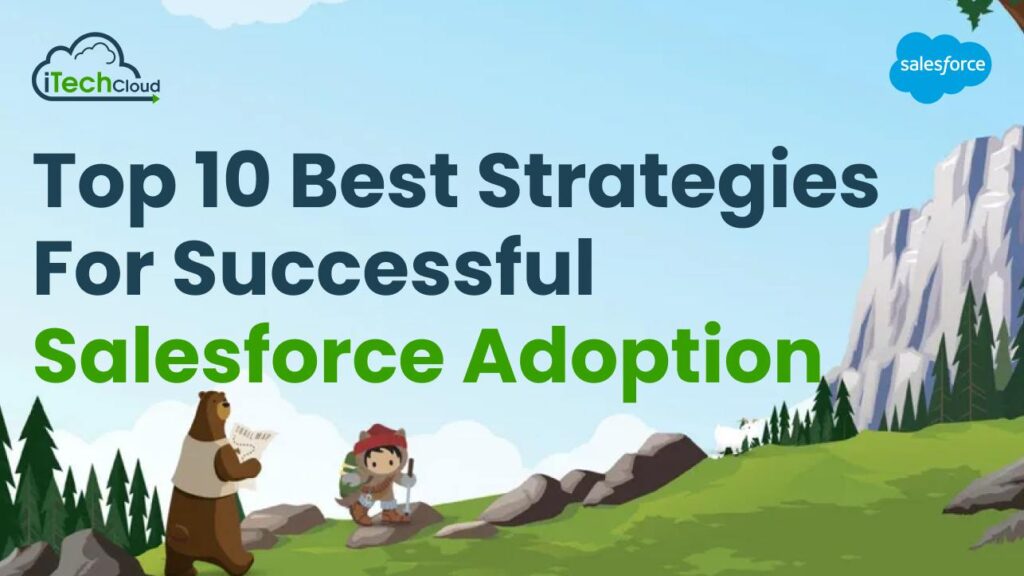Top 10 Best Strategies for Successful Salesforce Adoption

Salesforce successfully requires a holistic approach that encompasses various strategies to ensure smooth adoption across the organization.
Here are top 10 strategies for successful Salesforce adoption.
Table of Contents
1. Define Clear Objectives and Goals:
Before embarking on Salesforce adoption, organizations must establish clear objectives and goals. This involves identifying pain points, areas for improvement, and desired outcomes that Salesforce can address. Objectives could include enhancing sales processes, improving customer service, or streamlining marketing efforts. By defining measurable goals and key performance indicators (KPIs), organizations can track progress and evaluate the success of Salesforce adoption over time.
2. Gain Executive Buy-In and Leadership Support:
Executive buy-in is critical for the success of any organizational initiative, including Salesforce adoption. Leadership support helps secure resources, align departments, and foster enthusiasm among employees. To gain executive buy-in, stakeholders must effectively communicate the benefits of Salesforce adoption, such as increased efficiency, improved decision-making, and enhanced customer satisfaction. Executives should lead by example, actively using Salesforce and promoting its benefits throughout the organization.
3. Create a Cross-Functional Implementation Team:
Salesforce implementation requires collaboration across different departments and functional areas. Assembling a cross-functional implementation team ensures that diverse perspectives are considered and that Salesforce meets the needs of various user groups. The team should include representatives from sales, marketing, customer service, IT, and other relevant departments. Assigning clear roles and responsibilities within the team ensures accountability and facilitates effective communication throughout the implementation process.
4. Invest in Comprehensive Training and Change Management:
Training is essential to ensure that users understand how to effectively utilize Salesforce to achieve their goals. Organizations should provide comprehensive training programs tailored to different user roles and skill levels. Training methods may include in-person workshops, online courses, and on-the-job training. Additionally, implementing robust change management strategies can help address resistance to change and promote user adoption. This may involve communication plans, user feedback mechanisms, and incentives for participation.
5. Customize Salesforce to Fit Organizational Needs:
Salesforce is a highly customizable platform that can be tailored to meet the unique needs of each organization. During implementation, organizations should work closely with Salesforce consultants or internal administrators to customize the platform according to their specific requirements. This may involve configuring workflows, creating custom fields, and integrating third-party applications. By customizing Salesforce to fit organizational needs, organizations can maximize its value and ensure a seamless user experience.
6. Promote User Engagement and Adoption:
Encouraging user engagement is key to successful Salesforce adoption. Organizations should communicate the benefits of Salesforce to employees and involve them in the decision-making process. Soliciting feedback from users and incorporating their input into the implementation process helps build buy-in and ownership. Additionally, organizations can incentivize participation through rewards, recognition programs, and gamification. By promoting user engagement, organizations can foster a culture of continuous improvement and innovation.
7. Provide Ongoing Support and Maintenance:
Salesforce adoption is an ongoing process that requires continuous support and maintenance. This may involve setting up a help desk, offering online resources, or providing access to Salesforce experts. Regularly updating and optimizing Salesforce ensures that it remains aligned with evolving business needs and technological advancements. By providing ongoing support and maintenance, organizations can maximize the long-term value of Salesforce.
8. Monitor Performance and Measure Success:
Monitoring performance and measuring success are essential aspects of Salesforce adoption. Organizations should regularly track KPIs and metrics to assess the impact of Salesforce on business outcomes. This may include monitoring sales performance, customer satisfaction scores, and user adoption rates. By analyzing data and identifying trends, organizations can make informed decisions and continuously improve their use of Salesforce. Additionally, organizations should solicit feedback from users to identify areas for improvement and address any issues proactively.
9. Continuous Learning and Development:
Salesforce is a dynamic platform that undergoes regular updates and enhancements. To ensure that users stay informed about new features and best practices, organizations should encourage continuous learning and development. This may involve providing access to training resources, hosting user groups and community events, and encouraging participation in online forums and discussion groups. By investing in continuous learning and development, organizations can empower users to leverage Salesforce to its full potential and drive innovation within the organization.
10. Celebrate Success and Recognize Achievements:
Recognizing and celebrating success is essential for maintaining momentum and motivation throughout the Salesforce adoption journey. Organizations should acknowledge and celebrate milestones, achievements, and success stories related to Salesforce adoption. This may involve hosting recognition events, highlighting success stories in company communications, and rewarding individuals or teams for their contributions. By celebrating success and recognizing achievements, organizations can reinforce positive behaviors and foster a culture of success.
Conclusion:
Successful Salesforce adoption requires a multifaceted approach that encompasses clear goal-setting, executive buy-in, cross-functional collaboration, comprehensive training, customization, user engagement, ongoing support, performance monitoring, continuous learning, and celebration of success. By implementing these strategies effectively, organizations can maximize the value of Salesforce and drive meaningful business outcomes.

